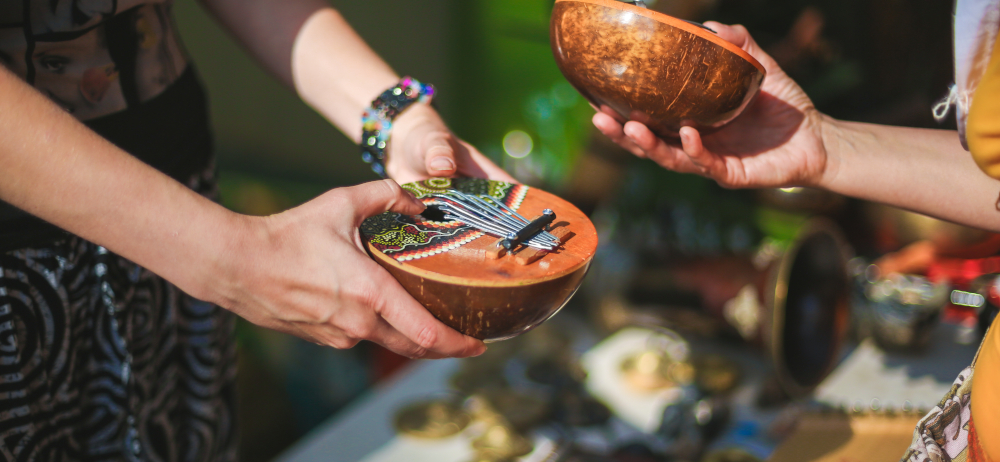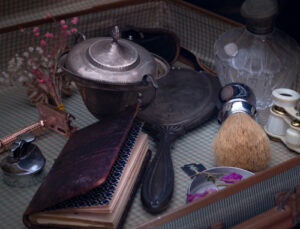
The Hand-Me-Down Economy
In South Africa, nothing enters a home without a history. That new kettle on the counter? It once belonged to your aunt who got it from her wedding registry, and now it’s heating water in your kitchen because she finally upgraded to one with LED lights. The couch you watch soccer on? That’s your parents’ old one, patched and revived more times than you can count. Even the baby’s cot had three previous occupants, cousins, neighbours, and a family friend who never returned the baseboard screws. We live in a hand-me-down economy, where objects carry memory like perfume clings to a scarf.
In our households, new is often just a different kind of old. Not second-hand, not charity, but inheritance, of the unspoken kind. You don’t get a dining table, you receive one, scratched with the Sunday meals of another generation. You don’t buy a saucepan; it arrives in a black bag with a loose handle and a note that says, “Still works.” The plates don’t match, and that’s not a design choice, it’s a legacy. The pink one with the chip belonged to your gran. The heavy white one came from someone’s starter pack when they moved into res.
It’s not just stuff. It’s rhythm. It’s how you grow into a world that has already been lived in, softened by the elbows of others. Your first school uniform is never bought. It’s zipped up by your older cousin and smells faintly of Sta-Soft and anxiety. The sleeves are always a bit too long, and the collar never sits right, but it’s yours, because it once belonged to someone who got through the same grade you’re trying to survive now.
Even your first cellphone is a hand-me-down. A scratched-up relic with a cracked screen protector and mysterious saved numbers like “Bra Sbu Welding” and “Mkhulu Church.” You delete nothing. Because it’s not really your phone until it becomes filled with your own chaos layered on top of the last owner’s traces.
Cars too. We don’t do “brand new off the lot.” We do “starts on the third try,” “just got new tyres,” and “don’t use first gear unless you’re on a hill.” That 1998 Corolla in the driveway is more than a vehicle, it’s a generational pact. It fetched kids from school, carried Sunday groceries, and now it’s teaching your brother how to parallel park with a radio that only works when you hit the dash in the right spot.
Our homes are museums of resilience. The Tupperware drawer is a hall of fame of butter containers and old yogurt tubs that now store everything but what they were intended for. The curtains are hemmed with hand-stitching from someone who “used to sew back in the day.” Even the broom is probably a fusion of three past brooms, Frankenstein’d together with black tape, an old mop handle, and determination.
Hand-me-downs aren’t just practical, they’re emotional architecture. A mug from your childhood somehow ends up in your adulthood kitchen, still carrying the chipped lip and Sunday Milo memories. A Bible with four generations of names inside gets passed on like a family map. Even jokes are handed down. The way your father used to tease you about your haircut is now the exact line you use on your nephew. That’s cultural continuity, not copy-paste laziness.
 There’s an intimacy in using things that came before you. A kind of ancestral acknowledgement in the way we hold onto chairs with squeaky joints and shirts with one too-short sleeve. You don’t throw them out, you adapt. Because throwing it away would mean discarding a piece of someone’s effort, someone’s taste, someone’s time.
There’s an intimacy in using things that came before you. A kind of ancestral acknowledgement in the way we hold onto chairs with squeaky joints and shirts with one too-short sleeve. You don’t throw them out, you adapt. Because throwing it away would mean discarding a piece of someone’s effort, someone’s taste, someone’s time.
And when something truly breaks, it doesn’t go to the bin first. It goes to the garage. To the back room. To the cousin who “can fix anything.” There is no such thing as useless. There is only “not working yet.” And when something finally becomes irreparable, its parts still live on, a stove knob becomes a cupboard handle. A broken crib becomes a chicken coop. A faded dress becomes a floor rag. Our homes operate like patchwork economies stitched together with memory, need, and invention.
Even fashion in South Africa has this multigenerational twist. That jacket from your uncle’s varsity days? It’s somehow trendy again. The church hat your gran wore in the 80s now headlines your cousin’s TikTok fashion reel. What we wear isn’t just about the present, it’s about where it’s been before us, and where it might go next. And maybe that’s why, when we do get something new, brand new, shiny and boxed, we treat it like an artifact. The remote gets wrapped in plastic. The couch stays covered in that noisy clear vinyl. The kettle is operated like it’s nuclear tech. Because we know the road ahead. That newness is temporary, and life is long. That object will eventually be passed down, scuffed, redefined.
You’ll give it to your sister when she moves out. She’ll give it to her son when he starts working. One day, it’ll come back to you, unrecognisable, but still working, like the family itself.
The hand-me-down economy is not a sign of lack. It’s a sign of longevity. It says, “We make things last because we made it through.” It says, “We carry each other, even in spoons and shoes and schoolbags.” It’s a quiet rebellion against disposable culture. A stubborn insistence that stories matter, even if they’re held in a cracked plate or an old radio.
And in a world that’s obsessed with the new, the fresh, the untouched, we know better. We know that some things are better after they’ve been loved. After they’ve held other hands. After they’ve witnessed birthdays, heartbreaks, and load-shedding dinners.
Because nothing in a South African home is just an object.
It’s an heirloom, waiting for its next chapter.




